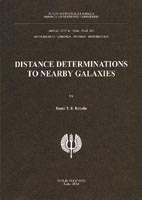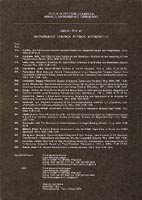Thesis of Rami Rekola

|

|
Click on thumbnails to see the front and back cover in larger size.
|
Most Finnish scientific theses nowadays are composed of several
publications (4-6 or even more) and an introductory part (several tens
of pages). Because of copyright reasons, I can only give links to the
publications. Actually these links lead to ADS (The NASA Astrophysics Data
System), which is the most comprehensive list of publications in astronomy,
and publicly available. The ADS provides the abstract of the publication and
gives links to the full text - these links lead to commercial (i.e.
chargeable) pages of scientific journals. The entire introductory part of
my thesis is presented here as a PDF file.
Introduction
Publication 1
Publication 2
Publication 3
Publication 4 (temporarily unpublished; the link will be added as soon as the artice appears in MNRAS)
Dissertation
In Finland dissertation, or disputation as it is also called,
usually lasts from 90 min to several hours - depending on how thorough
the opponent is. There is only one opponent, who is often from abroad
since he must be a specialist in the field but not have any common
publications with the disputant. The dissertation begins with a 20 minute
presentation the disputant will give on the topic of the thesis - in
Finnish. Then the opponent gives a wee speech. The main part of the
dissertation is next with the opponent going through the thesis material
and asking questions related to it. At the end he gives a short statement
on whether he recommends the doctoral degree to be granted or not.
Then the custos (a chairman or moderator) asks the audience if anybody
wants to ask questions. This means that people may become additional
opponents. Additional opponents must write a statement to the Faculty
of Mathematics and Natural Sciences in which they either recommend
or don't recommend a doctoral degree. In real life it is extremely
rare - almost nonexistent - nowadays to have additional opponents and
it is considered very odd if that happens.
There is no special dress code at the dissertation for the audience.
If the opponent has recommended a doctoral degree, the doctoral
candidate organises a dissertation party in the same evening. This is
a formal dinner party with special dress code for everybody. Men should
dress in tail coat with white shirt, white vest, white tie, black leather
shoes (shiny or matt) and a white handerchief in the breast pocket OR
in a dark suit (black, or coloured but very dark, with a white shirt,
dark socks and shoes, and a necktie or bow tie that matches with the suit.
Women should dress in an elegant black or dark dress, a jacket suit
or a trouser suit, and festive shoes.
People should arrive to the dissertation party (karonkka in
Finnish) in due time. It is held in honour of the opponent and people
should show respect to the opponent (and doctoral candidate) by arriving
in time. The opponent should be the last to arrive. There will be a
toast in the beginning, followed by the dinner. After the main course
the doctoral candidate holds a speech thanking the opponent and custos
(and possibly other people directly connected with the thesis work) who
then thank him in brief. There should be no clapping hands at any moment.
After the dinner, the party usually continues in a free format -
in the same location or in a nearby restaurant or pub.
Photographs from my dissertation and party may be viewed
here.
Bureaucracy
My thesis work was supervised by professor Mauri Valtonen
and adjunct professor Chris Flynn, both from Tuorla Observatory.
Prior to dissertation my thesis was reviewed by professor
Burkhard Fuchs from Astronomisches Rechen-Institut,
Heidelberg, Germany, and professor Brad Gibson from
Centre for Astrophysics and Supercomputing, Swinburne University of
Technology, Hawthorn Victoria, Australia.
I had my dissertation at the University of Turku on 18th December 2004.
My opponent was professor Gene Byrd from The University of
Alabama, Tuscaloosa, Alabama, the United States of America.
The Faculty of Mathematics and Natural Sciences at the University of
Turku accepted my thesis with honours on 20th January 2005.
Master's thesis
My master's thesis was a study of Local Group dynamics. I ran computer
simulations on movements of a dozen Local Group galaxies under the
influence of Newtonian gravity. All simulations incorporated Maffei
group of galaxies with the assumption it originated from the Local
Group either by slingshot processes or, more likely, as a group that
passed through the Local Group and was accelerated to its current
outwards radial velocity. Some simulations incorporated Sculptor group
of galaxies similarily.
To be continued...
|  Links
Links



